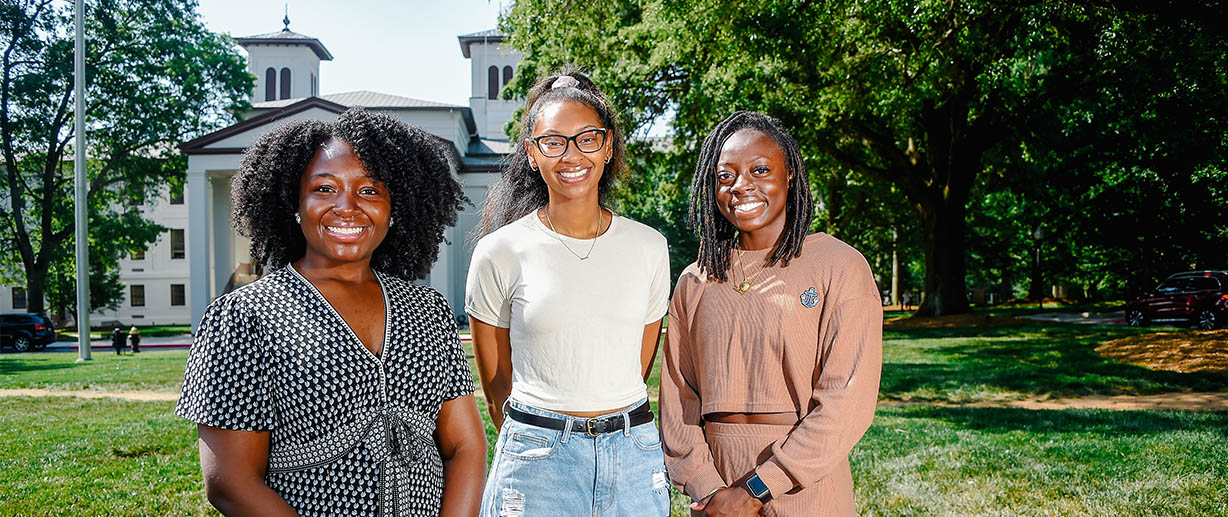This spring, Alea Harris ’22, Dieran McGowan ’22 and Destiny Shippy ’22 reviewed their scripts, recorded voice-overs and posed for photos. By mid-July, a new public walking tour of Wofford College will be available, and it’s rooted in their research, persistence and commitment to sharing Wofford’s history.
“This is us trying to leave Wofford better than we found it,” says Shippy.
The research for the project started two and a half years ago during a research methods Interim with Dr. Rhiannon Leebrick and a Council of Independent Colleges grant to study Wofford’s past and how it connects to the Spartanburg community. That grant was a collaboration between Rebecca Raulerson Parrish ’99, grants specialist at the time; Jessalyn Story, director of the Center for Community-Based Learning; Luke Meagher, special collections librarian; and Brad Steinecke, assistant director of local history with the Spartanburg County Public Libraries.
In the research methods Interim with Harris and McGowan were Kaycia Best ’20, Bryson Coleman ’23 and Vera Oberg ’20. Harris and Best were paid through the grant to continue the work during the spring. The goal was to present their findings to the CIC and at the Spartanburg County Public Libraries, but COVID19 altered plans. Unable to deliver a culminating presentation, the group continued to pore through archival materials and secondary sources. Shippy and McGowan joined the research group during the summer, and the researchers met weekly with Dr. Tasha Smith-Tyus, who helped them think through how the research could be used. Harris, McGowan and Shippy then helped Leebrick turn their research into a publication, and they presented the findings via Zoom during the fall of 2020. Eyon Brown ’21 and Noah Ravan ’23 began editing the research document in the spring of 2021 to create a user-friendly tour of the campus that includes the college’s common history.
“This project was always meant to be the beginning of a conversation about public memory and a way for undergraduate students to get hands-on research experience,” says Leebrick, an assistant professor of sociology and anthropology.
For the three women who have seen the project from its infancy to completion and for Best, who was an early leader, it has been much more.
“We were evaluating ourselves and where we learn and grow and how this affects us,” says Shippy.
“We were connecting the dots,” says Harris, who spent time investigating leads in archives across the Upstate as well as at Wofford. “Every name was important to filling out a complete story and coming to terms with what had happened and what was happening.”
They discovered the complexities of archival research and the importance of documentation as they read the papers of each of Wofford’s past presidents. The Interim group had traveled to Montgomery, Alabama, and met Freedom Riders; they sparked conversations about how history is shared in a variety of ways. The student researchers talked with some of Wofford’s first Black students and benchmarked the work other colleges and universities are doing to share their histories.
Best interviewed Doug Jones ’69, Wofford’s first African-American graduate. After Dr. Phillip Stone ’94, college archivist, shared letters that the college received during integration, she had questions, and Jones provided answers.
“The most interesting part of archival research for me is the chase,” says Best, who is now a flagship manager with Enterprise in Rockingham, North Carolina. “You find one little piece of information, and you follow the leads until you discover the complete story. It can be tedious, but it’s worth it.”
Spending time in the archives with boxes and boxes of materials, some of which were full of fragile scraps of paper, gave McGowan a sense of urgency. “I realized that vital documents could get lost so easily... or overlooked... or forgotten,” says McGowan. She was particularly concerned that Wofford students know the story of the college’s integration told in President Charles Marsh’s papers. “There were nuances in the Marsh papers about integration that could easily be missed, and we didn’t want that to happen.”
“The student researchers were phenomenal in the passion and professionalism they brought to their work,” says Leebrick. “What an amazing group of young scholars.”
Dr. Dwain Pruitt ’95, chief equity officer, and Stone also supported the students by reviewing the finished project.
“This is great,” says Best, referring to the new tour. “The goal was always to make Wofford’s history more available to students.”
More details about the self-guided history walking tour, including a website dedicated to it, will be available later this summer.
